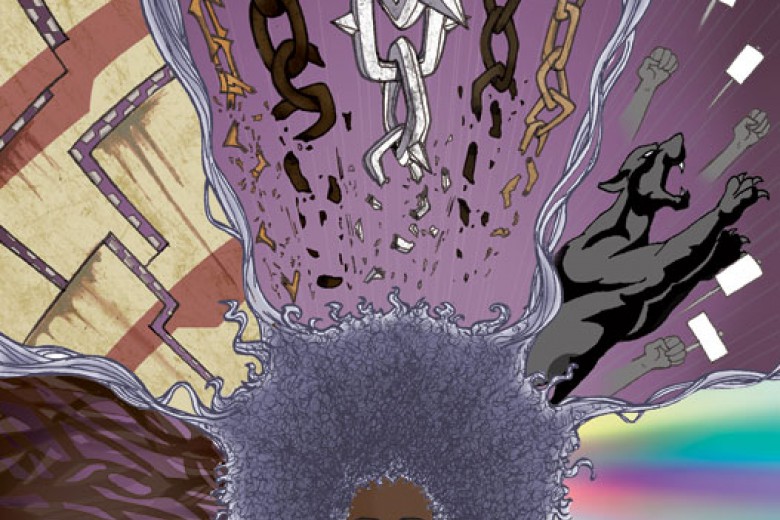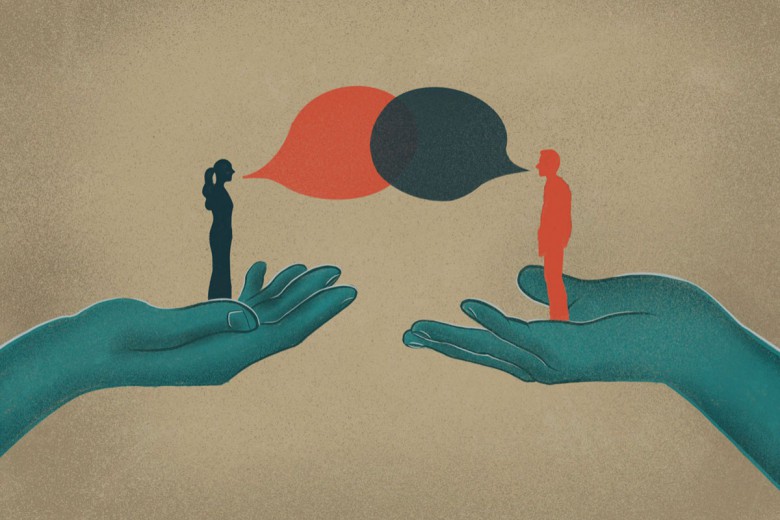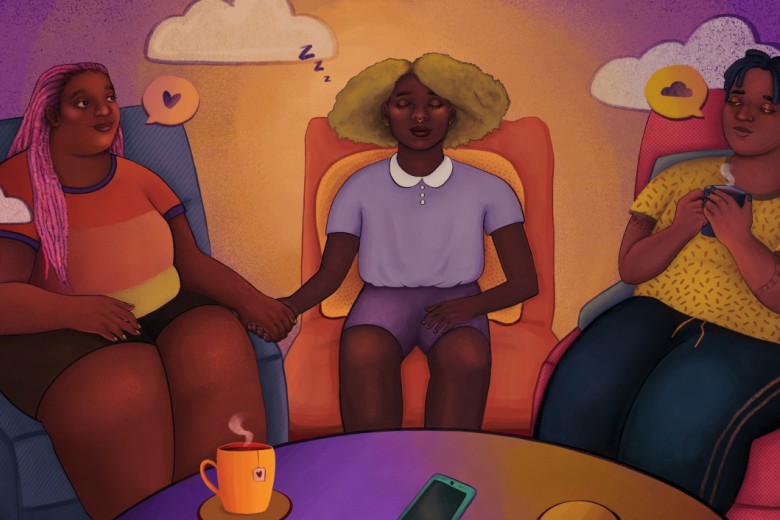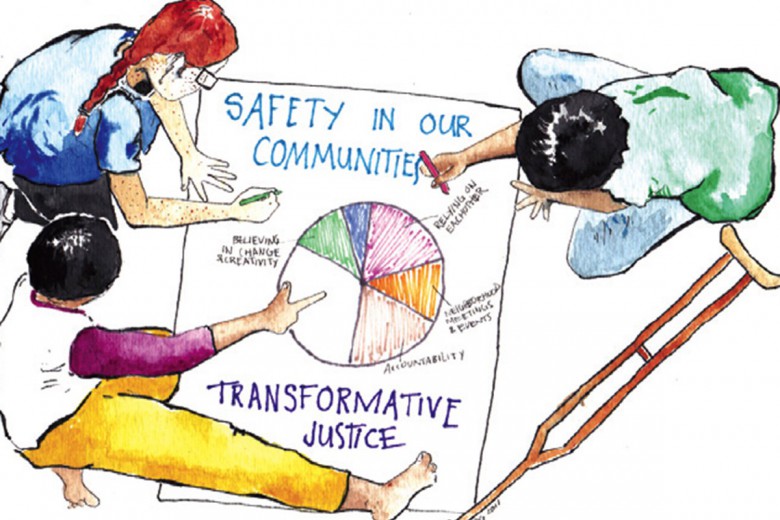“We were never meant to survive. Welcome home.” – Alexis Pauline Gumbs
Part 2 of “If Black Women Were Free” (Part 1 can be found here and in the September/October 2016 issue) provides an in-depth look at the history of transformative justice and the Third Eye Collective and looks at ways transformative justice can be put into practice in non-Black spaces in ways that honour its origins and expertise.
We want to note up front that transformative justice in Indigenous and Black communities is intertwined, and both of these origins of TJ deserve their own full emphasis. This article focuses on the history of transformative justice in Black spaces; we encourage all readers to engage with Leanne Betasamosake Simpson’s Indict the System, and to build knowledge about the crucial, long-standing, and ongoing transformative justice work led by Indigenous women and two-spirited people.
The skills and tools of transformative justice, generated by Black women in response to daily lived realities, are needed everywhere that harm and gendered violence occurs. Gendered violence is woven through all of our spaces. An inability to heal and to hold one another through experiences of harm – whether as bystanders, those who harm, or those who are harmed – eventually upends every movement space if it is not handled well. The capacity to lean into these difficult conversations is therefore a fundamental organizing skill.
The simple act of survivors speaking about any kind of gendered violence can spark intense erasure and backlash, which makes naming the violence extremely difficult. To make speaking up more possible, we need a cultural shift away from guilt-ridden binaries toward transformative justice.
Hopelessness, despair, guilt or shame can prevent the needed skills from emerging. And yet inspiring models of healthier relating exist and are already in practice in other communities. We can grow these skills here, learning from what has come before. We need real forms of accountability, and to replace guilt and shame, and the defenses they foster, with processes that can keep everyone safer.
We hope that this conversation can be useful, both for readers in Black communities thinking about how to deepen TJ practices and for non-Black readers who want to respectfully engage with TJ practices without erasing Black women’s historical experience and expertise.
NS: Can you talk a little more about the history and the context in which TJ arose?
RZ: Transformative justice, I believe, was always intuitive work for Black women, for whom racism and gendered violence cannot be separated. Concepts and understandings central to TJ, such as the idea of multiple interlocking oppressions, have been part of Black women’s resistance since slavery. This knowledge is woven through the work of community leaders such as Ida B. Wells, and is crystallized in part through the writing of the Combahee River Collective, who described intersectionality first as a way to self-name. Kimberlé Crenshaw coined the term “intersectionality” in the late 1980s to describe the embodied realities of Black women.
NS: What do you think would need to shift in this culture for TJ to feel safer for Black women, particularly older Black women, when they are asked to play a role in accountability processes?
RZ: Well, this kind of work takes small communities – pockets, if you will – of people who can hold and expand very difficult conversations about sexual violence and other forms of gendered violence … and so that means cultivating a small community of people who have first started working through their own histories of trauma, and who are also committed to that personal work so that they can show up in a safe, ongoing way in these conversations.
One path to accountability work that involves our elders, I feel, means creating a culture of conversation around sexual violence for our relatives and our elders who may not have ever spoken about their own trauma experiences. The learning and healing that can take place in these spaces is tremendous. Again, TJ is about starting in the smallest spaces, I believe. My conversations, for example, have happened in kitchen corners with my auntie at Thanksgiving time over the years. And more recently around my grandmother’s bed as she was dying. It just felt right, while my aunt and uncles were in the room together, to talk about the incest in our family that my grandmother was never able to speak about. I knew even as a teenager that it was one of the things that had stolen her joy and embittered her. The vulnerability that was already present in that room while she lay dying led to me later talking with my aunt about my cousin – her son – for the first time. I felt so free of that weight, telling her about the ways he used to put his hands on me, especially after her response was, “My god, I never knew. What do you need from me?” I trust in that power of speaking the truth about sexual violence. And I have witnessed the freedom that can come with it – even with our elders.
NS: It seems to me that people who are asked to support TJ and who themselves survived violence are often unable to speak. Not only do they often have the hardest time naming what they see, they are also the least likely to be heard by others. This is an effect of trauma: the inner well of silence that survivors carry can make speaking up exceptionally difficult.
Meanwhile, if those who have the most power or influence in a given circle have not themselves experienced this kind of violence, they may find it hard to see what is happening right in front of them. Or they may partially perceive it, or believe the woman, but not feel able to name or protect her because they are more aware of the feelings of the abuser than of the urgent needs of the woman who has been harmed. Abuse can be so subtle. Often the person who has abused gets to determine the baseline of reality, gets to control or manipulate how the process works, and those around them accept this or cannot perceive the depths of harm that are right in front of them. Women might feel they’re screaming into a void, where their voice is lost even to those who directly witness abusive dynamics. This is in some ways the hardest part of the experience.
So what we have to face is that those who can see it have to heal before they can speak, and those who can speak have to develop emotional maturity, empathy, perceptiveness, and bravery before they can recognize and name what is happening right in front of them.
We have so few emotionally reliable, safe men, and our healing needs them. The idea that the masculine-identified people in our lives we count on to understand and have our backs may not be healed enough to be safe or to see what is happening can be too much to bear. One way patriarchy gives masculine-identified people power is to threaten to cut ties to prevent the accountability process, or focus everyone on the needs and feelings of the abuser.
The instinct to placate can be strong if we expect that masculine-identified people may attack or abandon. Those who are socialized within masculinity often have not grown up with the expectation to be responsible for their own emotions, and they don’t even realize that people, especially the more feminine people around them are managing their emotions as well as our own.
For those of us who have so few safe harbours, genuinely safe and accountable masculine-identified people in our lives, the fear of losing a friend if we name harm can be too much to bear and is a powerful silencing strategy in this culture. I think this is part of why the both/and approach can be powerful: the fact that harm has been named does not mean the person who did the harm is bad.
Unfortunately, men who have a strong inner guilt and shame landscape may only hear their own inner feelings of guilt and shame, and may lash out or flee, which is an extremely frightening control measure for those of us who grew up with abuse in our daily lives. Male feminism or allyship means nothing if it is not accountable. Shifting the emphasis from guilt to accountability can allow us to love the men we have in our lives while also expecting them to step up into owning their shit and being genuinely present and accountable.
RZ: I certainly think about this in how I relate to my own children when they do messy, unacceptable shit: you are responsible for your actions but you are not a shameful human being. You did this thing, you are still loved and okay, and you are expected to make it right. That ground of love can make it more possible for men to be accountable, and for people to speak up.
NS: Speaking of creating possibilities, the Third Eye Collective has generated a lot of interest because it is doing work that is unusual in Canada. Can you talk a bit more about how the collective formed, what sparked it, and where you see this work going?
RZ: We were first approached to respond to a situation in which a long-time community member and organizer had assaulted his partner.
We initially reached out to a woman in our community who identifies as a Black feminist and also has a long organizing history in this city to support us in an accountability process with the aggressor, whom she had known for a long time. Her response was hostile. And for her at the time, it was enough to say, “Well, we go way back and he’s never harmed me, so I can’t believe you and do the accountability work that you’re asking me to do.”
It was such a hard moment because it was the first time that the woman who was harmed had ever opened her mouth and shared in such detail what had happened to her in her assault. And then to face another Black woman who says, “Nah, I’m riding with dude,” there is just no more painful a place for a Black woman to be … maybe losing a child. And so, what felt life-affirming for me in response at the time was to write an open letter to the women who identified as a Black feminist and say, “This is where we have to start with this work” – without shaming her, without naming her in the letter. What felt life-affirming in that moment was to say, “This is exactly how it’s always been in the Black communities I have lived in,” and then to create a checklist of things that we have to start doing differently – to face one another and to believe other Black women who come to us and dare to open their mouths, knowing what they have at stake.
That first year of the collective was about eating together often, drinking wine at my kitchen table, and doing really pragmatic shit: lending direct support on a very small and local scale. Then, after a year, we said, “Hey, we’ve got some really solid trust bonds here. What would it mean to create a collective that envisions us 10 years from now having a safe house for Black women? A space that supports and knows how to support Black women who are constantly threatened with having their children placed in foster care? What would creating a space that radically supports Black women in this town look like?” Montreal is new to this work and this kind of support for Black women, for reasons that deserve a separate conversation. The number of silenced stories that have been shared with us over the last few years has been, I think, the most devastating aspect of this work. It also propels us greatly.
NS: I find it interesting that in TJ, it’s a victory for the women who have experienced harm to talk to one another. The formal legal system, as we saw in the Ghomeshi case, discourages or disallows women who have been harmed from talking to one another. And yet when harm is systemic and normalized, it causes dissociation. Talking together about what you have experienced can help put the pieces back together. Speaking, simple naming, is incredibly hard. The gap between word and lived reality can make people feel crazy; talking together can help clarify reality, to get it back. I have witnessed – actually, in retrospect I have participated in – entire circles around an abuse dynamic that disguise the fact that it is happening, even to themselves, or blame it on the woman, because what happens in the most intimate spaces can be so masked and because we so badly need to believe that the men we rely on, who get cred as allies, are actually doing their own emotional work to be safe. Even understanding what has happened can be so incredibly difficult if it contradicts a man’s words and beliefs about himself.
Other men can be a good resource, especially those who have worked through their own issues, or who have abused in the past and successfully done their own accountability work and who recognize how this evasiveness looks. This is a very important role for men who have themselves acted in abusive ways to grow into as part of their own healing. The Bay Area Transformative Justice Collective observes in their pod mapping workshop that building an accountability pod for those who have harmed others is a challenge; often people end up colluding with the one who has harmed in their attempts to build rapport with someone who is taking accountability for harm they have caused. It is important to understand that this knowledge is a gift, and it is not the job of the woman who has been harmed to make this kind of accountability happen – this is the work of masculine-identified people. When we see the ways gendered violence operates together with anti-Black racism, it is clear this is also non-Black people’s work.
Can you talk about how non-Black organizers can use transformative justice practices in ways that are accountable to their sources and context? How might this work differently for POC organizers, and for white organizers? For instance, I first learned the concept of intersectionality in highly stylized ways in university classrooms and anti-oppression trainings – the idea that we all have multiple “intersecting identities.” I’ve since learned that this way of teaching TJ concepts, without talking about the history or the specific ways Black women’s lives are intersectional, erases Black women. I’ve also understood from your class that anti-Black racism works in this kind of quiet erasure, where Black women are often encouraged to silence themselves, and also that speaking about their experiences may feel like “shouting into the wind.” How can we – speaking as a white organizer here – use TJ practices in ways that are respectful?
RZ: Intersectionality and TJ are useful concepts for everyone, I believe, but they need to be used in ways that acknowledge their roots.
Using TJ properly is partly about knowing and naming its origins. Using “intersectionality” in its context, for instance, names that Black women were always inherently living multiple oppressions at once.
NS: So, Black women’s wholeness depends on keeping these things together, not fragmenting them.
RZ: Yes. Things to keep in mind in non-Black POC and white communities pertain to how we use language and what gets erased with particular kinds of language. For example, the term “racialized” in its practical application in Canada erases Blackness specifically because it is used to conclude that there is “diversity” in an organization or space. But that diversity may not include Black people specifically because it unfairly privileges a particular experience – one that is non-Black in whatever way “Blackness” or Black cultural expressions are showing up in that community. On the other hand, an invocation of Blackness conjures an imaginary threat and an imaginary intention to dominate, and this is just damn exhausting to fight within POC and self-designated radical spaces. Anti-Blackness intends everywhere to present Blackness first as a threat, because that is what it has been designed historically to do.
White supremacy doesn’t only attach to white bodies; hierarchies of power structured by white supremacy attach to all kinds of bodies: Asian bodies, Muslim and Arab bodies, Latino bodies. And anti-Blackness similarly attaches in complex ways.
TJ will resonate in POC communities in different ways than it will in white spaces, because there are things white organizers just don’t have to think about. I’m thinking of the fragility of some newly arrived or first-generation families, in conservative communities, and the ways some of my students feel responsible for the impacts on their parents, and who may not want to identify their families by naming the violence they have experienced within them – in these cases, TJ occurs when we do the direct support for those women who are choosing not to do visible community accountability work. Tangibly supporting one another with food and phone calls when people are struggling, that is already a victory. Checking in with people daily, organizing to send over hot meals, making sure someone eats and showers … that is what TJ work looks like in that situation.
NS: You offer support for so many people while doing your work – your parenting, teaching, legal support. How do you handle so much?
RZ: For me, there is something transformative and also bolstering about leaning into the most difficult thing, the hardest place within myself again and again, until it becomes like water washing over me. And that has come through my parenting work, as well as my own personal healing relationship with violence.
There is also something essentially life-affirming about saying, “I am not going to work within institutional systems of violence; I am going to find another way.” I have come to understand that the systems of state violence – the police, departments of youth protection – are structured to dismantle and further violence within Black families. My personal understanding of TJ – and perhaps this will shift as I age – is a commitment not to work closely within those systems, and that is inherently life-affirming work to me.
NS: The emphasis on relationship building and accountability in our interpersonal relationships comes back to that generative-strategy approach that transformation is fractal. adrienne maree brown has explained that the work has the same pattern at each level of scale. Transformation begins in each of us, and then it in turn changes how we are with one another. Healing at that relationship level transforms how utterly resilient and indestructible we can be in our more formal organizing spaces as we directly challenge power, because we can be good to each other so we can be effective together. In other words, doing social justice work that does not just replicate old patterns of violence in our organizing requires transformation in ourselves, which creates transformation in the very fabric of our relationships with one another, and these fundamentally transform how we can show up in a resilient way in our organizing strategies. And that this is how deep system change occurs in nature: not in a top-down way, but in an emergent way. Grace Lee Boggs and Charity Hicks seem to have led in this way. I came late to the party, but I have had more hope in my life and in our collective power once I understood what that means.







